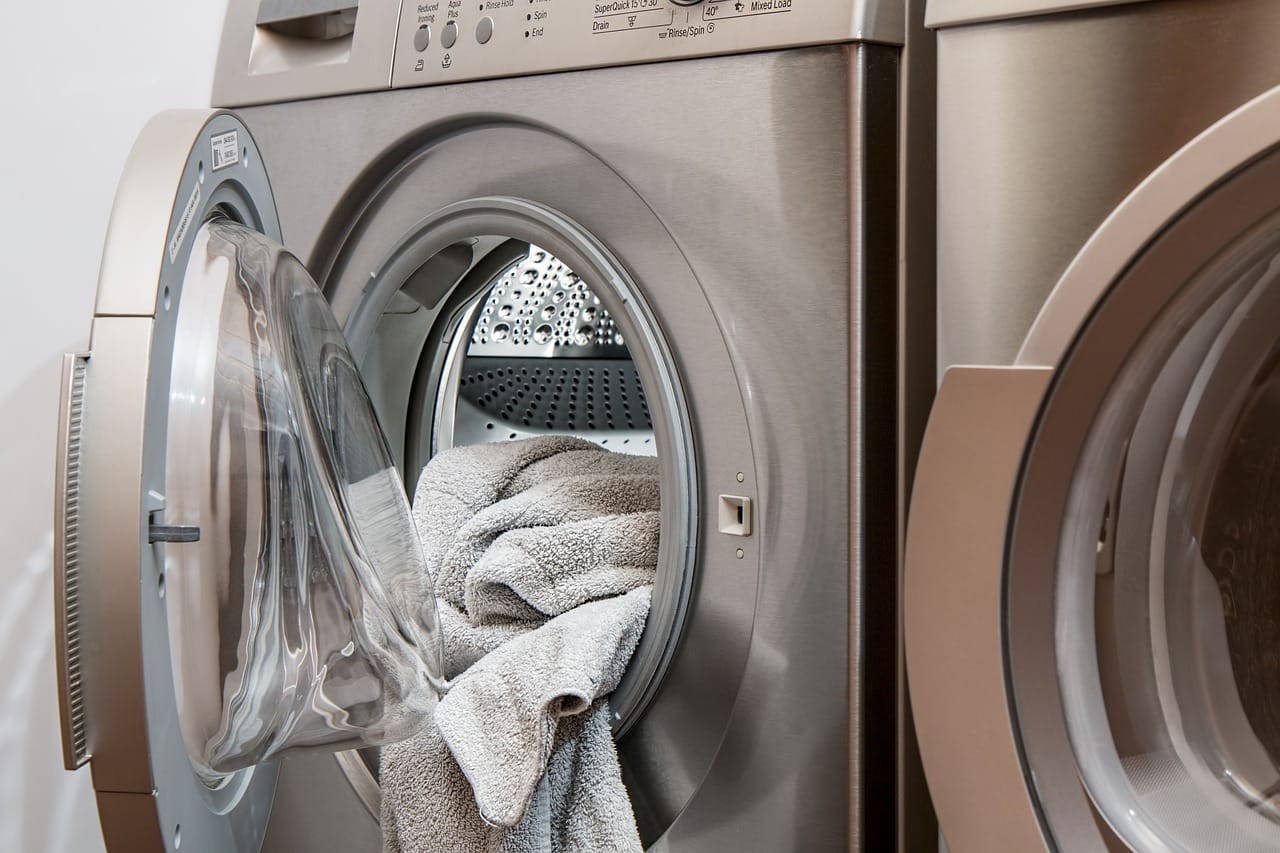A washing machine dripping from the bottom, or worse a full on leak causing a flood, is a serious issue. Water spilling across your floor can cause floorboards to rot, mold to grow and various other problems to occur. It’s also a pain to constantly have to be mopping to avoid puddles forming. If you’ve got a washer leaking from the bottom, here’s what might be causing it and what to do about it.
1. Loose or Damaged Drain Hose
Probably the most common cause of a washer leaking from the bottom is a problem with the drain hose. It may have come loose where it joins your machine or plumbing or have gotten damaged somehow. Either way, the result is often puddles on the floor.
The drain hose, as the name suggests, carries wastewater away from your machine towards the drain. The vibrations of your washer running can occasionally knock it loose at either end and, being lightweight and flexible, it’s often susceptible to getting damaged.
If you notice your washer leaking from the bottom during the draining part of the washing cycle, pull it out and inspect the hose. If there’s visible damage, unscrew it and replace it. If you can’t see and signs of wear and tear, tighten it up where it connects to the back of your washer and see if that sorts the issue.
2. Worn or Cracked Door Seal
The door seal, unsurprisingly, creates a seal between the door and the body of the machine. This allows you to open your front-loading washer without running the risk of water pouring out during use. They’re made from a rubbery material which the door compresses, creating a watertight seal, when closed.
Unfortunately, rubber is prone to perishing over time, becoming brittle and cracked. When this happens, the seal won’t be nearly as efficient and might let water trickle through. Even if your machine isn’t very old, mold or debris might be blocking the seal and creating space for water to escape through.
Regular cleaning and, if it’s torn or overly worn, replacing the gasket should avoid these issues.
3. Faulty Water Pump
The water pump helps drain water out of your machine during washing cycles. As with any moving mechanical parts, they’re susceptible to wear and tear and will eventually malfunction. What this means for you, in practical terms, is a washer leaking from the bottom.
There are various things which could be contributing to the failure of your washer’s pump. Cracks, blockages and loose connections are all likely candidates. Diagnosing a failure could come from observing pooling water under the machine, spin cycles which don’t wring out enough water or large amounts of liquid being left in the drum at the end of a wash.
While you might be able to fix a loose connection or blockage yourself, it’s often more sensible to simply replace the pump or call in a pro.
4. Internal Hose Issues
While washing machines aren’t the most complex of technology, they do have a surprising number of components. Most of these deal with water flow and require a network of interior pipes to function.
These interior hoses are susceptible to problems like cracking, loose connections and blockages. As your machine works, it vibrates really quite a lot and this can occasionally knock a connection out of place, resulting in a washer leaking from the bottom.
While you might be able to gain access to most of them and inspect them yourself, this one is often best left to the pros. Schedule a regular inspection to make sure everything is complete and tight and replace anything that’s worn out.
5. Overloading the Washer
Your washer is designed to take a certain weight of washing and exceeding this can cause all kinds of problems. Most modern machines control how much water is added to each step of the cycle by judging the contents by weight. Overloading the machine means too much water is added and can cause overflows.
Likewise, putting in too much detergent can create too many suds. These can find their way out of the machine in various ways, mimicking a leak.
To avoid these issues:
- Run smaller loads
- Follow the instructions on your detergent
6. Cracked Tub or Drum
The tub or drum (depending on your style of washer) holds the washing and water- it’s the bit of the machine that does most of the actual washing.
Over time, wear and tear will take their toll and holes or cracks could form. Likewise, accidental knocks could split the tub and allow water to escape.
When this happens, you’ll require the services of a qualified professional. It may even make more financial sense to simply replace the whole machine.
7. Clogged or Malfunctioning Drains
Within your washer is a drain valve which allows the wastewater to leave the machine when it’s finished with. Overtime, this will age and start to malfunction or get blocked by the various bits of debris which pass through it. Likewise, your home’s drains themselves aren’t immune from things going wrong. Blockages can form.
Whether it’s the washer itself or the drainpipe, the result is much the same: a backup, leaking and flooding.
Luckily, these are relatively easy thing to fix. Regular cleaning cycles and drain maintenance can avoid clogs and blockages forming. If your drain valve is failing, a professional should be able to replace it without too much bother.
8. Leaking Water Inlet Valves
The water supply connects to your washing machine via an inlet valve. This simple device allows your machine to control the flow from the water main, meaning that it’s not constantly sucking up the wet stuff. Though they’re remarkably simple devices, things can and do go wrong.
The hose which connects the valve to your water supply can come loose, allowing water to escape. Likewise, the valve itself could fail. The obvious signs are a leak coming from around the connection at the back of your machine.
The first thing to do is ensure that the connection is tight. Simply screw the plastic threaded connector on tighter, compressing the rubber ring inside it. If this doesn’t work, ask your plumber to replace the valve itself.
9. Detergent Drawer Overflow
The drawer into which you put your detergent and fabric softeners is designed to let water flow through it. This allows the contents to be dispersed through the machine and eventually drained back out again.
If you put too much detergent into the drawer (especially powdered forms), the flow of the water can be disrupted. This could potentially lead to the water sneaking its way out from the front of the drawer, leaving a soapy puddle under your washer.
Another potential cause of a leaky detergent drawer is a build-up of gunk (that’s the technical term) in the drawer. Soap produces scum and, eventually, this combines with impurities in the water to produce a sticky residue. Left alone for long enough, this could restrict the flow through the drawer and result in an overflow.
Simply cleaning out the drawer from time to time and following the instructions on your detergent should rectify these issues.
10. Uneven Installation or Vibrations
If you’ve ever tried to lift your washer, you’ll know that they can be incredibly heavy. This is thanks to containing a large block of concrete, designed to stop your machine from ‘walking’ across the floor during the spin cycle. This weight means that it’s really important to ensure your washer is level before using it.
As the drum spins, it creates vibrations and this can loosen connections within the machine. If the machine isn’t level or the load is unbalanced, the risk increases.
It’s fairly simple to level a washing machine. The feet on which it sits can be adjusted up or downwards by twisting them, allowing you to fine tune it. Make use of a spirit level and ensure that the bubble sits square in the middle.
Balancing the load means taking a bit more care when loading the machine, ensuring there’s not too much in the drum and it’s evenly distributed.
When to Call a Plumber
As you’ll have noticed, a lot of washing machines which leak from the bottom can be sorted with a little thought. That being said, if the issue keeps happening or seems complex, calling a plumber will solve it quickly and efficiently, especially if it requires replacing parts.
Whether you opt for a DIY fix or to call in the big guns, moving quickly is important. Left unattended to, problems have a habit of getting worse and more expensive to fix. What starts as a tiny drip can quickly become a flood. The knock-on effects will also worsen overtime and could involve things like floorboards rotting or mold growing.
If you’ve ever got any questions or concerns about your washer, Paragon are ready and waiting to bring our expertise to bear.

